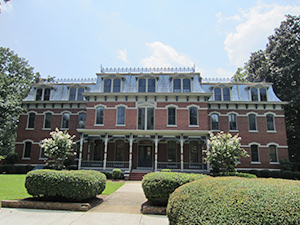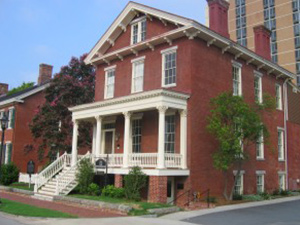Start Your Walking Tour Around Historic Augusta Georgia
Select a neighborhood from the list below or use the search to find a specific home or location.

Broad Street
The Broad Street corridor was the commercial center of Augusta and the surrounding area until suburban malls were developed in the latter 20th century. It’s buildings are constructed along the sidewalk, and most shared adjacent walls. Street levels have always been used for commercial spaces, while the upper floors have been both offices and residential. Here you will find many restaurants, entertainment venues and shops.

Greene Street
The Broad Street corridor was the commercial center of Augusta and the surrounding area until suburban malls were developed in the latter 20th century. It’s buildings are constructed along the sidewalk, and most shared adjacent walls. Street levels have always been used for commercial spaces, while the upper floors have been both offices and residential. Here you will find many restaurants, entertainment venues and shops.

Telfair Street
Although not designed with the central parked median like the one found on Greene Street, Telfair Street is a close rival for it’s outstanding collection of churches and institutional buildings. It also served as a fashionable address for affluent Augustans in the 19th and early 20th Centuries. Its western end changed character after World War II when the automobile sales district of Augusta expanded to that area.
Walking Tour FAQ’s
- Reynolds Street was named for Colonial Governor John Reynolds.
- Jones Street was named for the family of Noble Jones of Savannah, who was the original surveyor of the Colonial town of Augusta.
- Broad Street is a reference to the width of the main commercial street in the historic town plan.
- Ellis Street was named for Colonial Governor Henry Ellis.
- Greene Street was named for Revolutionary War General Nathaniel Greene.
- Telfair Street was named for Georgia Governor Edward Telfair.
- Walker Street was named for Augusta Mayor Freeman Walker.
Streets that are oriented from north to south were mostly numbered in 1880 to facilitate emergency response by police and firemen. All had original names that also reflect the city’s history:
- Fifth Street was originally called Center Street, indicating the original center street in the colonial town of Augusta.
- Sixth Street was originally called Washington Street, named for General George Washington who would later become the first President of the United States.
- Seventh Street was originally called McIntosh Street, named for Georgia Revolutionary War General Lachlan McIntosh.
- Eighth Street was originally called Jackson Street, named for Georgia Revolutionary War General James Jackson, who later became a Georgia Governor.
- Ninth Street was originally called Campbell Street, named for Martin and Macartan Campbell, original settlers and traders in Augusta. In 1993 it was renamed James Brown Boulevard for the internationally known soul singer who called Augusta home.
- Macartan Street has retained its historic name, and was named for Francis Macartan, an 18th Century trader in Augusta.
- Tenth Street was originally called Cumming Street, named for Thomas Cumming, first Intendent of Augusta after it was incorporated as a City in 1798.
- Eleventh Street was originally called Kollock Street, named for a prominent Georgia Family connected to the Noble Jones Family.
- Twelfth Street was originally called Marbury Street, named for Capt. Leonard Marbury who developed the Village of Springfield on the confiscated lands of the Loyalist James Grierson, after the Revolutionary War.
- Thirteenth Street was originally called McKinne Street for a prominent local family of merchants.
The mission of Historic Augusta, Inc. is to preserve historically or architecturally significant sites in Augusta and Richmond County, Georgia.
